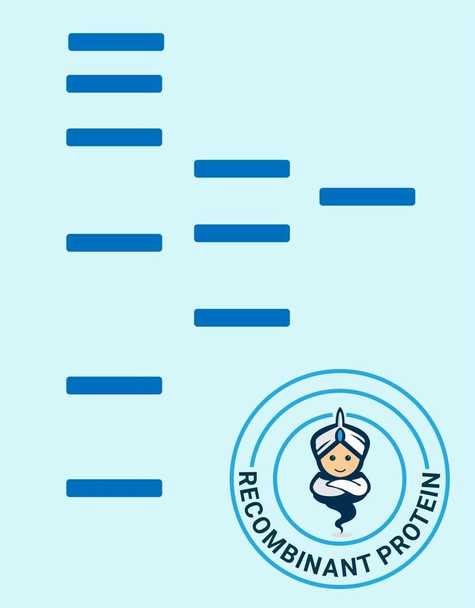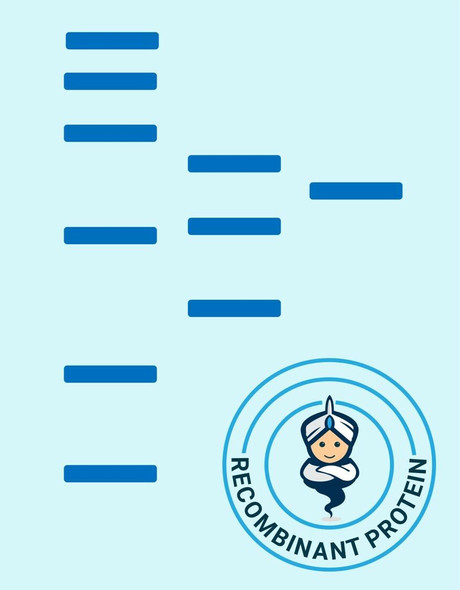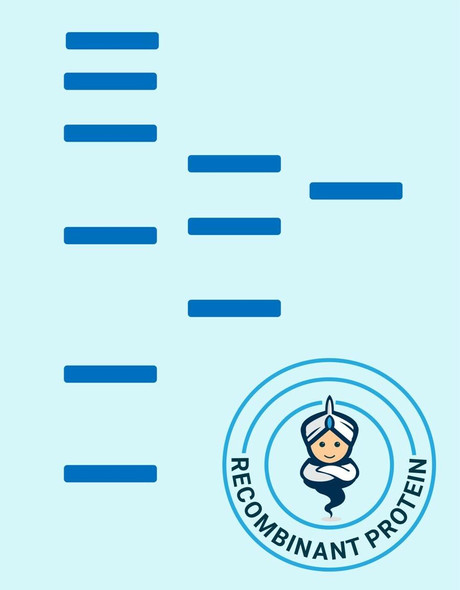Description
| Product Name: | Human CENPA Recombinant Protein |
| Product Code: | RPPB3144 |
| Size: | 20µg |
| Species: | Human |
| Target: | CENPA |
| Synonyms: | Histone H3-like centromeric protein A, Centromere protein A, CENP-A, Centromere autoantigen A, CENPA. |
| Source: | Sf9 Insect cells |
| Physical Appearance: | Sterile Filtered liquid formulation. |
| Formulation: | CENPA is supplied in 20mM HEPES buffer pH-8, 100mM sodium chloride, and 6M Urea. |
| Stability: | Store at 4°C if entire vial will be used within 2-4 weeks.�Store, frozen at -20°C for longer periods of time.�Avoid multiple freeze-thaw cycles. |
| Purity: | Greater than 90% as determined by SDS-PAGE. |
Centromere proteins are a group of proteins which form and/or mediate the function of centromeres, the central structures of chromosomes to which spindle fibers/microtubuli attach and pull the chromosomes apart in cell division. Currently, 9 centromere proteins are known and designated CENPA to CENP-I. Most of the centromere proteins are targets of autoantibodies, the anti-centromere antibodies.CENPA is another important centromeric autoantigen in addition to CENPB: it has a molecular weight of approx. 20 kDa and is incorporated into centromeric chromatin due to its histone-like properties. CENPA antibodies are an important marker for correct diagnosis of Scleroderma / CREST syndrome in CENPB-autoantibody negative patients.
CENPA Human Recombinant produced in SF9 is a glycosylated, polypeptide chain having a molecular mass of 17,015 Dalton. CENPA is expressed with a -6x His tag and purified by proprietary chromatographic techniques.
| UniProt Protein Function: | CENPA: a basic nuclear protein of the histone H3 family. May act as a core histone necessary for the assembly of centromeres. Contains a histone H3 related histone fold domain that is required for targeting to the centromere. CENPA is proposed to be a component of a modified nucleosome or nucleosome-like structure in which it replaces 1 or both copies of conventional histone H3 in the (H3-H4)2 tetrameric core of the nucleosome particle. |
| UniProt Protein Details: | Protein type:DNA-binding Chromosomal Location of Human Ortholog: 2p23.3 Cellular Component: chromosome, pericentric region; condensed nuclear chromosome, pericentric region; cytosol; nucleoplasm; nucleus Molecular Function:chromatin binding; protein binding Biological Process: DNA replication-independent nucleosome assembly at centromere; establishment of mitotic spindle orientation; kinetochore assembly; sister chromatid cohesion |
| NCBI Summary: | Centromeres are the differentiated chromosomal domains that specify the mitotic behavior of chromosomes. This gene encodes a centromere protein which contains a histone H3 related histone fold domain that is required for targeting to the centromere. Centromere protein A is proposed to be a component of a modified nucleosome or nucleosome-like structure in which it replaces 1 or both copies of conventional histone H3 in the (H3-H4)2 tetrameric core of the nucleosome particle. The protein is a replication-independent histone that is a member of the histone H3 family. Alternative splicing results in multiple transcript variants encoding distinct isoforms. [provided by RefSeq, Nov 2015] |
| UniProt Code: | P49450 |
| NCBI GenInfo Identifier: | 1345726 |
| NCBI Gene ID: | 1058 |
| NCBI Accession: | P49450.1 |
| UniProt Secondary Accession: | P49450,Q53T74, Q9BVW2, D6W544, |
| UniProt Related Accession: | P49450 |
| Molecular Weight: | 13,001 Da |
| NCBI Full Name: | Histone H3-like centromeric protein A |
| NCBI Synonym Full Names: | centromere protein A |
| NCBI Official Symbol: | CENPA�� |
| NCBI Official Synonym Symbols: | CenH3; CENP-A�� |
| NCBI Protein Information: | histone H3-like centromeric protein A |
| UniProt Protein Name: | Histone H3-like centromeric protein A |
| UniProt Synonym Protein Names: | Centromere autoantigen A; Centromere protein A; CENP-A |
| Protein Family: | Histone H3-like centromeric protein |
| UniProt Gene Name: | CENPA�� |
| UniProt Entry Name: | CENPA_HUMAN |






